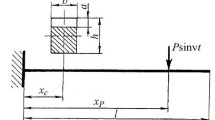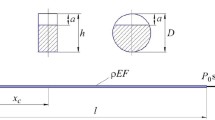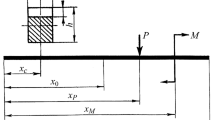The paper presents analytical and numerical methods based on finite element modeling for determining vibrodiagnostic indicators of the presence of a transverse edge crack closing in a cantilever composite beam made of orthotropic material. The results of studies of the effect of its presence on the change in the main vibration frequency and on the ratio of the amplitudes of the dominant harmonics at the main, superharmonic order 1/2, and subharmonic order 2 resonances are presented. It has been shown that for a composite beam reinforced in the bending plane with unidirectional fibers with their laying angles relative to the axis of 0...40°, it is advisable to use the change in the natural vibration frequency as a vibration diagnostic indicator, and for larger angles, the ratio of the amplitudes of the dominant harmonics at super- and subharmonic resonances may be of practical importance.




Similar content being viewed by others
References
M. Krawczuk and W. M. Ostachowicz, “Modelling and vibration analysis of a cantilever composite beam with a transverse open crack,” J Sound Vib, 183, No. 1, 69–89 (1995). https://doi.org/https://doi.org/10.1006/jsvi.1995.0239
O. Song, T.-W. Ha, and L. Librescu, “Dynamics of anisotropic composite cantilevers weakened by multiple transverse open cracks,” Eng Fract Mech, 70, 105–123 (2003). https://doi.org/https://doi.org/10.1016/S0013-7944(02)00022-X
M. Kisa, “Free vibration analysis of a cantilever composite beam with multiple cracks,” Compos Sci Technol, 64, 1391–1402 (2004). https://doi.org/https://doi.org/10.1016/j.compscitech.2003.11.002
V. V. Matveev and O. E. Boginich, “The influence of inelastic resistance on vibrations of an elastic body with a closing crack under the main and subharmonic resonances,” Strength Mater, 46, No. 1, 1–17 (2014). https://doi.org/https://doi.org/10.1007/s11223-014-9511-4
V. V. Matveev and E. A. Onishchenko, “Analysis of vibrodiagnostic parameters of the presence of a breathing surface crack of different configurations in a round bar,” Strength Mater, 49, No 6, 739–750 (2017). https://doi.org/https://doi.org/10.1007/s11223-018-9919-3
K. Avramov and T. Raimberdiyev, “Modal asymptotic analysis of sub-harmonic and quasi-periodic flexural vibrations of beams with cracks,” Nonlinear Dyn, 88, 1213–1228 (2017). https://doi.org/https://doi.org/10.1007/s11071-016-3305-0
Y. Murakami, Stress Intensity Factors Handbook, Vol. 1, Pergamon Press, Oxford (1987).
S. G. Lekhnitskii, Theory of Elasticity of an Anisotropic Body, Mir Publishers (1981).
K. Nikpur and A. Dimarogonas, “Local compliance of cracked bodies,” Compos Sci Technol, 32, 209–223 (1988). https://doi.org/https://doi.org/10.1016/0266-3538(88)90021-8
R. Ruotolo, C. Surace, P. Crespo, and D. Storer, “Harmonic analysis of the vibrations of a cantilevered beam with a closing crack,” Comput Struct, 61, No. 6, 1057–1074 (1996). https://doi.org/https://doi.org/10.1016/0045-7949(96)00184-8
V. V. Matveev, E. O. Onishchenko, O. L. Derkach, and O. E. Boginich, “Vibrodiagnostics of the presence of surface symmetrical cracks in beams of rectangular and round cross-sections by the characteristics of their nonlinear longitudinal vibrations,” Strength Mater, 54, No. 5, 785–801 (2022). https://doi.org/https://doi.org/10.1007/s11223-022-00455-7
O. L. Derkach, A. P. Zinkovskii, Ye. O. Onyshchenko, and K. V. Savchenko, “Notch-type damage influence on the frequency of the principal mode of the composite cantilever beam flexural vibrations,” Proc Struct Integrity, 36, 71–78 (2022). https://doi.org/10.1016/j.prostr.2022.01.005
Author information
Authors and Affiliations
Corresponding author
Additional information
Translated from Problemy Mitsnosti, No. 5, pp. 5 – 15, September – October, 2023
Rights and permissions
Springer Nature or its licensor (e.g. a society or other partner) holds exclusive rights to this article under a publishing agreement with the author(s) or other rightsholder(s); author self-archiving of the accepted manuscript version of this article is solely governed by the terms of such publishing agreement and applicable law.
About this article
Cite this article
Onyshchenko, E.O., Matveev, V.V., Derkach, O.L. et al. Vibrodiagnostics of the Edge Crack-Type Surface Damage in a Cantilever Composite Beam at Main, Super-, and Subharmonic Resonances. Strength Mater 55, 877–887 (2023). https://doi.org/10.1007/s11223-023-00578-5
Received:
Published:
Issue Date:
DOI: https://doi.org/10.1007/s11223-023-00578-5




